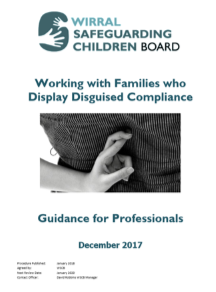Engaging with Resistant Families
The purpose of this webpage is provide guidance to assist professionals in working with children, young people and their families in circumstances where families are resistant to engaging with services.
Reasons that could hinder a family from engaging with services include:
• Fear of child/ren being removed
• Experience of poor service
• Learnt behaviour
• Do not recognise that there is problem (their norm)
• Multiple house moves (in and out of borough)
• Disability
• Learning disability
• Parental mental health
• Domestic abuse
• Drug and/ or alcohol misuse
• Cultural aspects
• Community status
• Criminal activity
• Lack of financial resources
• Low social support
• Trauma
Behaviours to consider that professionals might come across from a parent/ carer:
Ambivalence
• Mixed feelings/ contradicting ideas about someone or something
• Positive and negative components: on the one hand……. and on the other hand………
Denial/ Avoidance
• Refusal to acknowledge or accept
• Defence mechanism
• It’s not an issue for me
Confrontation
• Argumentative
• Head to head
Violence/ Hostility
• Physical force
• Intention to hurt or cause damage
When these behaviours are encountered, it could lead the professional to:
• Be avoidant of being persistent in trying to contact the family
• Feel fearful
• Feel out of their depth and unsure what to try next
• Be judgmental and make assumptions as to why the family are being resistant to engage
• Take it personally
• Respond to the behaviours e.g. be defensive, raise their voice, avoid challenge
• Close the case with no further action
Missing opportunities to make interventions could lead to:
• The needs of the adults eclipsing the needs of the child i.e. prevent the professional from seeing the child
• Removal of the focus from the child/ren i.e. disguised or superficial compliance can lead to a focus on the adult’s engagement with services rather than on achieving safer outcomes for children
• A reduction or downgrading in concern on the part of the professional allowing cases to drift
• Losing the opportunity to make timely interventions
• Potential for cases to be looked at without considering historic information i.e. families given a ‘clean slate’
• Over optimism about progress; professionals can become over optimistic about progress being achieved, again delaying timely interventions
Disguised Compliance involves parents giving the appearance of co-operating with child welfare agencies to avoid raising suspicions, to allay professional concerns and to delay or avoid professional intervention.
NSPCC 2010
WSCB Guidance Document: Working with Families who Display Disguised Compliance
Levels of engagement to be mindful of:
Non
- No response to letters, phone calls, text messages
- Does not answer the door
- If the door is opened professional not allowed in
- Non-attendance at meetings
- Child not in education
- N.B. No evidence of change for the child
Verbal
- Only respond via phone/ text messages (no face to face contact)
- Tell you they will comply and don’t follow this through
- Say what they think you want to hear
- N.B. No evidence of change for the child
Superficial
- Some engagement
- Let you in for home visits
- Attend meetings
- Say they will do what’s been asked of them
- Tell you they have completed the identified task
- Tell you there’s no longer an issue; everything is ok now
- Use deflective behaviours i.e. become emotional, defensive, blame someone else (adult’s needs eclipse those of the child)
- N.B. Little evidence of change for the child
Child focused
- Recognise the need to make changes
- Want things to be better for their child
- Willingly engage in meetings, home visits, interventions
- Complete identified actions
- Child in education
- N.B. Evidence that things are improving for the child
Consider:
What could be driving the presenting behaviours?
• When a need is being met behaviour will be more compliant
• When a need is being unmet behaviour could be more challenging
Iceberg Model
Over 85% of an iceberg is submerged beneath the water
Each iceberg is unique
Tip of the iceberg: Presenting behaviours are what we can see, hear, experience
Below the water mark: The reasons for the behaviours or the drivers
To be able to explore how to reduce or overcome the barriers to engagement we need to understand what the root causes are for the resistant behaviours. This will help us to plan what next.
Top Tips to try to overcome barriers to engagement:
• When working as part of multi-agency team consider who is best placed to try to build a relationship with the parent/ carer to limit the number of people trying to make contact
• Be persistent; if one approach isn’t working think of an alternative e.g. visit at a different time of day, arrange to meet in a neutral environment, remove your badge so it’s not visible, encourage the parent to have someone with them for support, check with other professionals what has already been tried
• Use supervision for support: talk through dilemmas, explore strategies, check what support is available for you if you feel threatened by presenting behaviours
• Regularly update services and share information of progress with engagement
• Always consider the ‘so what?’ for the child if the parent/ carer does not engage
• Be clear about the level of engagement; if a parent/ carer displays superficial compliance we can loose sight of the child
• If behaviour towards the professional is confrontational develop a safety plan e.g. joint visits, only meet in a venue where there is back up support
• Follow organisational policy and procedure regarding professional safety
Training available on the WSCB website: Engaging with resistant families.

